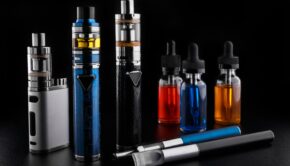What Is Synthetic Nicotine? An Overview of Tobacco-Free Nicotine (TFN)
If you vape, it’s likely that you’re going to be seeing the phrases “synthetic nicotine” and “tobacco-free nicotine” (TFN) often over the next year or two because there is a good chance that synthetic nicotine will play a major role in the future development of the vaping industry. For the first several years in which vaping existed, synthetic nicotine as an e-liquid ingredient was little more than a pipe dream. Vapers and vaping brands alike would have relished any opportunity to sever any connection between vaping and tobacco, but for many years, synthetic nicotine was simply too expensive to be of practical use in mass-produced products.
The way in which the vaping industry has evolved around the world over the past several years, however, has given laboratories a powerful incentive to figure out a way to make synthetic nicotine affordable enough for commercial use. Consumers are now beginning to see the fruits of those efforts in the form of products like the RipTide RipStick available from V2 Cigs UK.
The RipStick is a new vaping device that uses synthetic nicotine not derived from tobacco. It’s also a closed-system product that isn’t compatible with other companies’ products. Therefore, the RipStick is not a tobacco product and can’t be used in conjunction with tobacco products.
Why is that significant? That’s what you’re about to learn.
How Is Synthetic Nicotine Made?
The process of creating synthetic nicotine is something that’s closely guarded by companies in the pharmaceutical industry. There are several patents covering the creation of tobacco-free nicotine, and the process that’s currently most popular seems to involve creating a chemical bearing a molecular similarity to nicotine and then using a solvent to extract the nicotine molecule from that chemical. It will be more than a decade before the currently active patents for the creation of synthetic nicotine expire and enter the public domain, so for now, tobacco-free nicotine will remain a specialized product that only a few labs can provide.
Nevertheless, the current processes for creating synthetic nicotine were developed with cost effectiveness in mind. While synthetic nicotine undoubtedly costs more for e-liquid manufacturers to buy, consumers won’t pay inflated prices for the products. E-liquid has a high profit margin anyway, so manufacturers can generally absorb the higher cost of the synthetic nicotine without passing it on to consumers.
Does Synthetic Nicotine Feel and Taste the Same as Natural Nicotine?
Nicotine is always in high demand around the world, and that makes tobacco a very profitable plant to grow. Farmers who grow high-quality tobacco can always count on having high demand for their products because tobacco isn’t just the plant that powers the cigarette and cigar industries; it’s also the primary source of nicotine for e-liquid and for nicotine replacement products such as gums, lozenges and patches.
The reason why tobacco-derived nicotine is so affordable for companies such as e-liquid manufacturers to purchase is because nicotine is relatively easy to extract from tobacco. The extraction process merely requires tobacco biomass and a solvent such as ammonia. Ammonia is a powerful solvent, and it also raises the pH of the nicotine and frees it from the salt that binds it within the tobacco plant. Ammonia makes it possible to get a very high yield when extracting nicotine from tobacco, thus keeping the price of the nicotine low.
In addition to its predictable effect on the body, nicotine derived from tobacco has a characteristic peppery flavor. The flavor is noticeable in any product that contains nicotine and is consumed orally, whether it’s a nicotine gum or an e-liquid.
Proponents of synthetic nicotine, however, say that the peppery flavor of tobacco-derived nicotine is actually a drawback and could even be a sign of impurities such as tobacco-specific nitrosamines in the product. While synthetic nicotine e-liquids haven’t been distributed widely enough to get a consensus about the user experience from the vaping community, makers of synthetic nicotine claim that their products feel exactly the same when used and have a much smoother flavor stemming from a complete absence of impurities.
The standard line on tobacco-free nicotine is that it:
- Reduces throat irritation in e-liquid compared to tobacco-extracted nicotine at the same nicotine concentration
- Introduces less flavor of its own, thus allowing the flavor notes in an e-liquid to come through more clearly
How Will Synthetic Nicotine Change the Vaping Industry?
The key to what makes synthetic nicotine interesting for the vaping industry is the language that nations such as the United States and the United Kingdom use when regulating vaping products. Regulations such as the Family Smoking Prevention and Tobacco Control Act in the United States and the Tobacco Products Directive in the United Kingdom and Europe use the same phrase when referring to vaping products – they call those products “tobacco products.”
The phrase “tobacco product,” however, assumes that the e-liquid in an e-cigarette contains nicotine derived from tobacco. Do those same regulations apply to vaping products that contain no tobacco or tobacco derivatives? That’s what the makers of synthetic nicotine vaping products aim to find out.
The FDA’s answer to that question is vague – perhaps intentionally so. The website of the FDA says it’s “possible” that a closed-system vaping device using only synthetic nicotine may not meet the legal definition of a tobacco product and therefore would not be regulated by the FDA as such. The FDA says that it will evaluate synthetic nicotine vaping products on a “case-by-case basis.”
If a vaping product with synthetic nicotine falls outside the FDA’s jurisdiction, then it would be possible for companies to release new closed-system vaping products without going through the cumbersome and expensive premarket application process that essentially functions as a cost barrier preventing new companies from entering the American vaping industry. Such a product would have to be completely proprietary, however, thus preventing people from using that product with any e-liquid containing tobacco-derived nicotine.
If a company does attempt to release such a product without going through the premarket application process, however, that company will almost certainly need to battle the FDA in court. Litigation could prove to be just as costly as going through the premarket application process, so any company that plans to introduce a new synthetic nicotine vaping product in the United States will need to consider its options carefully before doing so.
Photo by Itay Kabalo on Unsplash
















